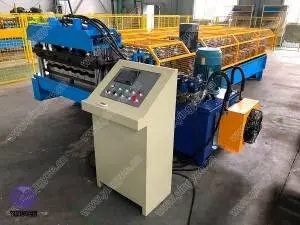
Understanding Suspended Ceiling T Grid Forming Machines
In the construction and interior design industry, impeccable aesthetics and functionality are essential. One critical aspect that contributes to these elements is the ceiling. Suspended ceilings, often referred to as drop ceilings, serve both practical purposes—like concealing plumbing, wiring, and HVAC systems—and aesthetic enhancements. A pivotal component in constructing these ceilings is the T grid system, which provides the framework for ceiling panels. To create these essential grid systems efficiently and consistently, manufacturers employ suspended ceiling T grid forming machines.
What is a Suspended Ceiling T Grid?
Before delving into the machinery, it's crucial to understand the components of a suspended ceiling. The T grid system consists of main runners and cross tees that form a grid pattern onto which ceiling tiles are attached. The “T” shape is fundamental as it provides the necessary strength and support while allowing for easy installation and removal of tiles for maintenance. The versatility of T grids enables a wide range of ceiling designs, making them popular in both commercial and residential installations.
The Importance of T Grid Forming Machines
Manufacturing T grids requires precision engineering and fabrication capabilities. This is where T grid forming machines come into play. These machines are designed to produce T grids efficiently, ensuring uniformity and quality in every piece produced. The use of advanced technology in these machines not only streamlines the manufacturing process but also reduces waste and costs associated with manual labor.
How T Grid Forming Machines Work
T grid forming machines operate through a series of mechanical processes. Initially, raw materials, typically galvanized steel or aluminum, are fed into the machine. The machine then performs several operations such as slitting, punching, and bending to transform flat sheets into the desired T shape. Here’s a brief overview of the key processes involved
1. Slitting The raw material is cut into strips of suitable width for T grid production. This step ensures that the dimensions are precise, setting the groundwork for quality output.
2. Punching After slitting, holes are punched into the strips. These holes serve multiple purposes, such as reducing weight and providing anchoring points for ceiling tiles.
3. Bending The key feature of T grid systems is their T shape. The pieces undergo bending processes that create the distinctive profile necessary for proper tile fit and support.
4. Cutting Finally, the formed T grids are cut to the required lengths, ready for packaging and distribution.
Benefits of Using T Grid Forming Machines

Investing in a suspended ceiling T grid forming machine offers several benefits
- Efficiency The automation involved in T grid production significantly reduces manufacturing time, allowing companies to meet demands swiftly.
- Consistency Machines ensure that every T grid produced is uniform, meeting industry standards and customer expectations.
- Waste Reduction With precise operations, material waste is minimized, resulting in cost savings and improved environmental impact.
- Scalability Manufacturers can easily adjust production quantities based on demand, making it easier to scale operations without compromising on quality.
Tips for Selecting a T Grid Forming Machine
When looking to invest in a T grid forming machine, several factors should be considered
- Machine Capacity Assessing the production capacity relative to your business needs is essential. Ensure the machine can handle the volumes you plan to produce.
- Material Compatibility Ensure the machine can work with the materials you intend to use, such as various grades of steel or aluminum.
- Automation Features Look for machines with advanced automation features that facilitate easier operation and maintenance.
- After-Sales Support A reliable manufacturer should offer robust technical support and maintenance services.
In conclusion, suspended ceiling T grid forming machines play a crucial role in the production of components essential for modern ceiling installations. Their efficiency, precision, and adaptability make them indispensable in the manufacturing landscape, driving innovation and quality in ceiling design. Whether you are a contractor, architect, or manufacturer, understanding and utilizing these machines can significantly enhance the quality and effectiveness of your ceiling projects.